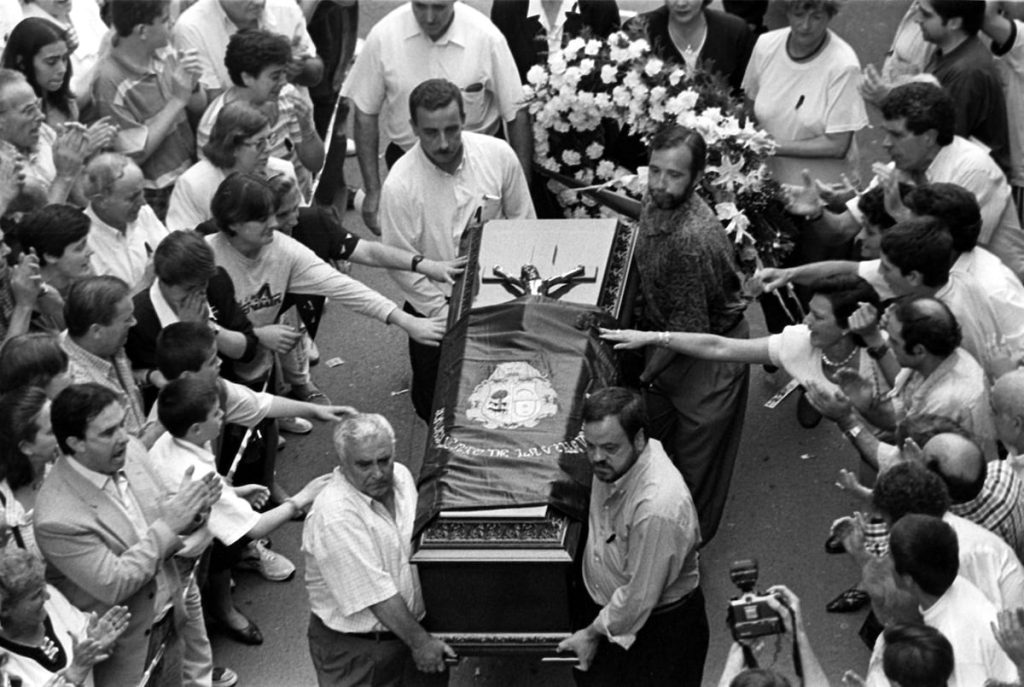The judge of the National Court Manuel García-Castellón has prosecuted four former members of the ETA leadership —José Javier Arizcuren, alias Kantauri; Mikel Albisu, Mikel Antza; María Soledad Iparraguirre, Anboto, and Ignacio Miguel Gracia Arregui, Iñaki de Rentería— for the kidnapping and murder of Miguel Ángel Blanco, a city councilor from the PP party in Ermua, in July 1997. The judge proposes to try them for crimes of kidnapping and terrorist murder with the aggravating circumstance of treachery, considering that they meet the requirements of indirect (or intellectual) authorship due to their control within the organization. The argument for prosecuting them, despite not being the material authors of the attack, is that as part of the ETA leadership, they could have prevented Blanco’s murder and did not do so, showing “an unequivocal intention to produce the result”. The judge has imposed a joint bail of two million euros on the four for potential civil liabilities in case of conviction.
This case, reopened following a lawsuit by the Dignidad y Justicia association, is one of several recent cases in the National Court aimed at trying former ETA leaders as indirect authors (inducers) of different attacks. Kantauri and Anboto are currently in prison, while Antza and Iñaki de Rentería are free. In a more than 100-page ruling, García-Castellón analyzes the actions of the terrorist group since its inception in the 1970s, highlighting its highly hierarchical structure with disciplined vertical command where orders from the “Executive Committee” were followed by operational units. Each member of a unit obeyed orders from their leader or liaison, knowing that behind those orders was the ETA leadership.
According to the judge, in 1997, as part of its destabilization strategy, the ETA leadership decided to target members of the ruling PP party by kidnapping a member and threatening their life to force the government to comply with their demands. It is deemed “improbable” that the Executive Committee did not order the kidnapping of Miguel Ángel Blanco since that body was responsible for deciding, planning, directing, and authorizing terrorist actions by ETA units. García-Castellón argues that the decision to kidnap the councilor required consensus from the entire leadership, not a single member, as evidenced by seized ETA documents showing that the defendants could have prevented Blanco’s death.
The judge explains that the charges against the defendants are based on omission, as they had sufficient command and decision-making power in the organization to prevent Blanco’s kidnapping or order his release. Despite the widespread appeals from society and politicians after Blanco’s kidnapping, the ETA leadership took no action to end the kidnapping or prevent the victim’s death, demonstrating a clear intention to produce the outcome. The requirements for indirect authorship by control of the organization, involving a hierarchical structure with strict discipline, where a directive body exercises control over immediate perpetrators, are met, according to the judge.
In conclusion, the prosecution of the four former ETA leaders for the kidnapping and murder of Miguel Ángel Blanco is based on their high-ranking positions within the terrorist organization, which conferred them the power to prevent or stop the crime but chose not to do so. This case sheds light on the accountability of individuals in leadership positions for crimes committed by the groups they lead, establishing a precedent for holding masterminds and decision-makers responsible for the consequences of their actions. The judge’s ruling underscores the importance of hierarchy and responsibility within criminal organizations, emphasizing the need to prosecute those who wield influence and control over violent acts, even if they did not commit them directly.


